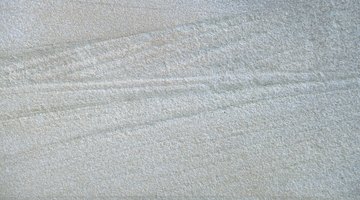What Is Expanding Cement?
Expanding cement, also known as expansive cement, is a relative of portland cement that contains materials that increase in volume as they set.

It's usually used with concrete mixes for situations where the shrinkage of conventional cement is undesirable or where the cement or concrete mix needs to create pressure on another part of a structure. Some products made with expanding cement can be used to seal small cracks and holes in concrete walls, such as foundation walls, and can help to prevent leaks in some applications.
Materials and Production
Expanding cement is made by using a portland cement base composed of kilned limestone, clay and gypsum. The limestone and clay are heated together to a temperature of around 2,600 degrees Fahrenheit, which transforms the material into dry pieces of cement. This material is ground with sulfoaluminate clinkers. These clinkers are made by kilning limestone, calcium sulphate and bauxite together at a temperature of about 2,300 degrees Fahrenheit. When exposed to water, sulfoaluminate expands in volume.
History and Development
According to the Encyclopedia Britannica, expanding cements were first invented in France during the mid-1940s. This cement included not just sulfoaluminate and portland cement but also blast furnace slag, which was added as a stabilizing agent. The result was the first successful expanding cement that worked reliably and remained stable over a long period. Another type of expanding cement, developed in Russia around the same time, uses portland cement, gypsum and alumina cement. Expansive cement ingredients have remained roughly the same since the product's development, though manufacturers have since improved the cement's predictability, strength and working time.
Uses and Benefits
Most portland cements shrink as they dry because the water used to activate them increases their volume. In some applications, this shrinkage can reduce the strength of the cement's bond to nearby objects and structures or create leaks. Expansive cements allow contractors to create large, continuous floor slabs without joints, and they work well to fill holes in foundations and to create self-stressed concrete that is stronger than conventional portland cement concrete. Prestressed concrete components for bridges and buildings are made using this material.
Misconceptions and Terminology
Expanding cement is sometimes referred to as hydraulic cement. However, any cement that reacts with water, including portland cement, is technically a hydraulic cement. All hydraulic cements, including expanding types, will cure under water, but some shrink considerably during the process. Choose an expanding-cement product that's listed as “expanding,” “sulfoaluminate” or “nonshrinking” to avoid this problem.
The Drip Cap
- Expanding cement, also known as expansive cement, is a relative of portland cement that contains materials that increase in volume as they set.
- This material is ground with sulfoaluminate clinkers.
- Expansive cements allow contractors to create large, continuous floor slabs without joints, and they work well to fill holes in foundations and to create self-stressed concrete that is stronger than conventional portland cement concrete.
- Prestressed concrete components for bridges and buildings are made using this material.
- Expanding cement is sometimes referred to as hydraulic cement.
References
Writer Bio
G.D. Palmer is a freelance writer and illustrator living in Milwaukee, Wis. She has been producing print and Web content for various organizations since 1998 and has been freelancing full-time since 2007. Palmer holds a Bachelor of Arts degree in writing and studio art from Beloit College in Beloit, Wis.
Photo Credits
- Ingram Publishing/Ingram Publishing/Getty Images
- Ingram Publishing/Ingram Publishing/Getty Images
More Articles



